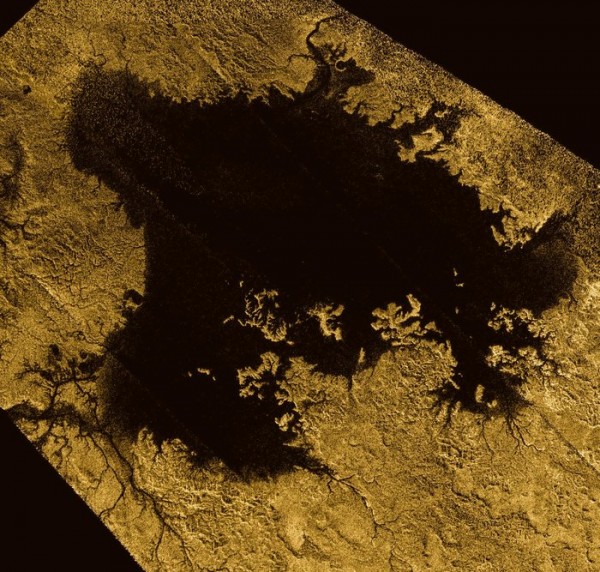By Ana Verayo, | May 02, 2016

Ligeia Mare, shown here in a false-colour image from the international Cassini mission, is the second largest known body of liquid on Saturn's moon Titan.
The mysterious moon of Saturn known as Titan, apparently possesses similar geological features with Earth, which includes a vast, mysterious sea. Our planet's seas contain water but on the other hand, Titan's seas are also in liquid form but filled with methane.
Titan's sea compositions was confirmed using the latest data from the NASA and European Space Agency's Cassini Huygens mission, as the spacecraft detected traces of methane emanating from lakes and seas on the moon.
Like Us on Facebook
These bodies of liquid methane are also located near the northern polar region, where Ligeia Mare is considered the second biggest of the three seas on Titan.
Mission scientists obtained radar images from Cassini where they have determined that Ligeia Mare is composed of mostly methane. However, methane on Titan acts differently compared to methane on Earth.
Using data sets collected from the Cassini radar between 2007 to 2015, scientists determined this methane composition of Ligeia Mare by temperature analysis of the heat emanating from this alien world's ocean.
Scientists say that lakes and seas such as the Ligeia Mare on Titan are formed with the same process as here on Earth, through collected rain.
However, since these are made from pure methane, this settles the argument of how prior studies suggest that Titan's liquid bodies are made from ethane, which is believed to be produced when methane is exposed to and broken down by sunlight, according to Cassini radar team's Alice Le Gall from LATMOS (Laboratoire Atmosphères, Milieux, Observations Spatiales).
NASA mission scientists also say that this particular methane sea on Titan is very similar to Earth when it comes to its formation due to similar weather patterns that also occur on Saturn's moon. Titan is also the only known planetary body in the solar system that possesses an atmosphere similar to Earth, composing of large liquid nitrogen and methane bodies. However, unlike Earth, Titan is low in oxygen supply to sustain a richer microbial life.
According to deputy lead scientist, Steve Wall for the Cassini radar team at NASA's Jet Propulsion Laboratory, this is also a marvelous exploration feat, accomplishing extraterrestrial oceanography on an alien moon, as Titan reveals more surprises. This news study is published in the Journal of Geophysical Research: Planets.
-
Use of Coronavirus Pandemic Drones Raises Privacy Concerns: Drones Spread Fear, Local Officials Say

-
Coronavirus Hampers The Delivery Of Lockheed Martin F-35 Stealth Fighters For 2020

-
Instagram Speeds Up Plans to Add Account Memorialization Feature Due to COVID-19 Deaths

-
NASA: Perseverance Plans to Bring 'Mars Rock' to Earth in 2031

-
600 Dead And 3,000 In The Hospital as Iranians Believed Drinking High-Concentrations of Alcohol Can Cure The Coronavirus

-
600 Dead And 3,000 In The Hospital as Iranians Believed Drinking High-Concentrations of Alcohol Can Cure The Coronavirus

-
COVID-19: Doctors, Nurses Use Virtual Reality to Learn New Skills in Treating Coronavirus Patients







